2014 Yamaha Apex XTX Review
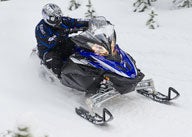
Power, comfort and long legs
Unleashing a four cylinder four-stroke snowmobile unleashes many memories for us. In 1992 Yamaha threw down a new set of snowmobile motor rules by offering a four cylinder two-stroke in its V-Max 4 800 (743cc). With its unique intake and exhaust note, the V-Max 4 gained fame with trail hustlers, lake blasters, quarter-mile asphalt burners, grass draggers and with the advent of the V-Max 4 ST (Super Track) for the mountains, the mighty four/four became synonymous with horsepower.
Engine Type:Horizontal In-line
Cylinders:4
Engine Stroke:4-Stroke
Valve Configuration:DOHC
Displacement:998 / 60.9
Starter:Electric
Turbocharged:No
View Full SpecShortly thereafter, the other OEMs were building motors that had more than two cylinders, Polaris with its 580 XLT (Xtra Light Triple; which eventually became a 600), Arctic Cat with its ZRT 600 and Ski-Doo with its Formula III 600. Eventually, these triples faded away and brought back in full color were two cylinder motors. Yamaha, on the other hand, moved away from two-stroke power all together to focus on four-stroke power with three and four cylinders.
As a young snowmobile journo, I would become drunken happy when sent out on trail and powder on a Vmax-4 800 at the annual test session. The motor’s strong bottom end torque, its maddening speed and aggressive looks made me feel strong.
So, now we turn to Yamaha and its allotment of 2014 model year sleds, specifically a review of the Apex XTX – a crossover snowmobile. We all know it is a 998cc four cylinder four-stroke snowmobile with electronic fuel injection where four 39mm fuel injectors feed the motor its petroleum nutrition. From Yamaha’s chronicles, the motor is known as Genesis. For many years, we’ve covered this motor and the Apex in general. We are no strangers to this Yamaha staple. Here is the nostalgia; we enjoy lighting up the mighty 4/4 and tearing the feathers off Mother Nature’s snowflakes. Old time Yamaha fanciers can think of this as Vmax-4 gone new school.
COMPARISON: 2014 Yamaha Phazer XTX Review – Video
The 2014 Apex XTX we evaluated at the annual manufacturers’ snowmobile photo shoot had Yamaha’s Electronic Power Steering (EPS), which makes the Apex XTX feel much lighter through the handlebars than it actually is.
EPS comes in handy as the Apex XTX tracks on a 144-inch Camoplast Rip Saw track that is 15 inches wide and clips the snow with 1.25-inch tall lugs. Keeping the track pointed in the right direction as it goes round and round is the dual shock CK 144 rear suspension. Impact energy at the rear is absorbed by a C40 R12.5 aluminum high-pressure gas (HPG) shock and a C40 R12.5 aluminum HPG with pressure clicker. Vertical travel for the rear skid is 11.7 inches.
Out front, the Apex XTX uses Yamaha’s new Tuner ski. The XTX’s center-to-center ski-stance is 42.5-inches. Controlling independent dual wishbone front suspension’s 8.6 inches of travel are 40mm aluminum-bodied, high-pressure gas (HPG) shocks.
We can’t say the Apex XTX isn’t heavy, but for its power-to-weight, its feels light, especially through the handlebars due in large part to its EPS.
Throttle pull on the big four-cylinder motor is light – our throttle thumb did not fatigue as we squeezed and released the flipper on the many long trails surrounding our West Yellowstone test venue. The cockpit area is large and spacious. However, with its wide motor comes a wide fuel tank. If you drive Yamaha’s new RS Viper XTX then take the Apex XTX for a drive, you’ll quickly notice the fuel tank’s width.
We found the Apex’s seat height felt a little low. When first sitting on the Apex XTX, seat height felt proper, but as the minutes clicked by, the seat began to swallow our sit bones. We believe the Apex seat to be soft, wide and when it compressed down, our hips dipped close to the runningboards; we wanted to stretch our legs more at the knee bend.
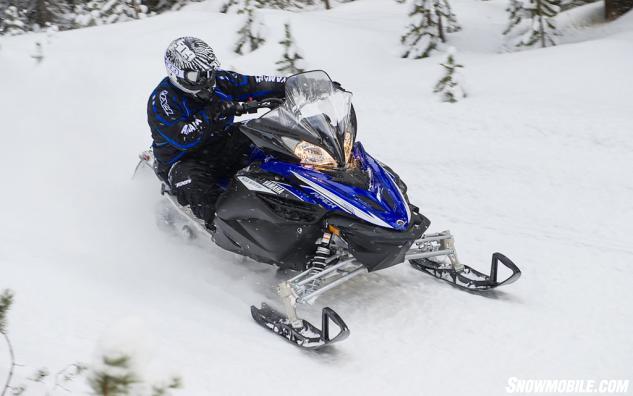 The Apex XTX whips up a frenzy on a trail where its power steering makes it easy to maneuver.
The Apex XTX whips up a frenzy on a trail where its power steering makes it easy to maneuver.
On the straight shoots, whippy curves and choppy moguls, we wound the speedo needle up past “Oh wow” and kept going to “Eyes Watering.” As the big four cylinder built speed, we often we had more throttle than trail. The Apex XTX is fast. It is a high performance snowmobile. Yet, it is tame and mellow, and too, driver-compliant. It will cruise at 45 mph in simplicity.
The electronic power steering system takes away any heft it takes to turn the Apex, especially during low speed maneuvers in deep snow or on crusty snow. However, when speed is built, the EPS takes away most handlebar feedback (pressure) to the driver’s hands. At times when making corrections we over steered, sending the sled outside our target line. With that said, power steering is wonderful, but understand that when weight transfer overcomes front end weight, the light feeling handlebars may lead the driver to over compensate turning to the right or left when engaged in full-on power.
COMPARISON: 2014 Polaris Switchback Assault Review – Video
Handlebar warmers on the Apex XTX work well and we like the heat adjustment ranges. Runningboards are wide and spacious, but lack aggressive traction and wide evacuation holes for snow and ice to fall through the platforms.
Wind protection on the Apex XTX is adequate. We found the faster we drove the Apex XTX, the oncoming air slipped around the bars and up over the helmet. The instrument pod is easy to read and does easily display engine and speed information.
Rear exhaust dumps are quiet, but when the Apex XTX is up to 40 mph or more, a staccato note emanates back to the driver. This is not a loud noise, but can be a tad annoying if the driver wears a helmet with little insulation near the ears.
The CK 144 rear suspension keeps the Apex XTX in control as it whacks choppy moguls, thanks in part to its 144-inch length. The independent A-arm front suspension with its adjustments did a good job at floating the heavier-than-two-stroke crossover snowmobile. However, we did feel impact energy travel up through the seat and feel that seat foam density could be stiffer.
The Camoplast Rip Saw track provided ample hook-and-go and did provide enough slip through the bends to keep the Apex in the direction the driver wanted it to go. However, with its vehicle weight and its 1.25-inch lug height, it is best to be a conservative deep powder rider; three feet of fresh fallen snow overly challenges the Apex XTX’s forward motion.
While Yamaha has been offering versions of the Apex for many years, it continues to sell and keep customers happy. This Apex XTX was, and is, a delight to ride. We feel the Apex line may see its production run end, knowing the RS Viper chassis is Yamaha’s new babe. The question is, can the Apex motor find its way into the RS Viper chassis? Answer…maybe. If Arctic Cat can stuff its big turbocharged twin cylinder four-stroke into the ProCross chassis (which is the RS Viper chassis), then with our guess, the Apex XTX may come to market in skinnier and tighter fitting clothes.
Our purpose of writing about the V-Max4 is not to dictate the future by discussing the past, but by drawing a straight line from one beloved Yamaha four-cylinder motor to the next.
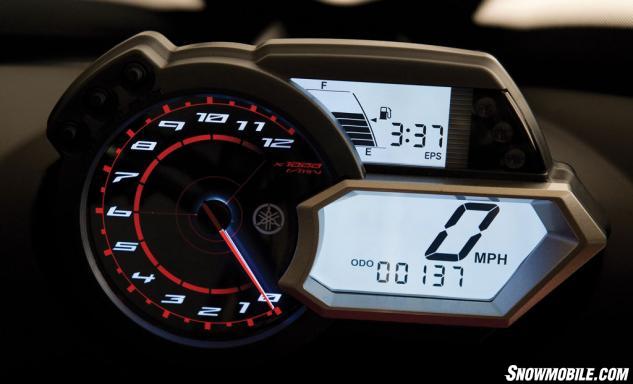 You can keep tabs on trail speed and engine performance with this easy-to-read display.
You can keep tabs on trail speed and engine performance with this easy-to-read display.
Now what for the Apex? As good as the snowmobile is – comfortable, good trail manners, ear flapping fast – it is time to give it a big refresh. But, can Yamaha top the Apex with another Apex? We have no answer to that question. So, could there be a new Apex molded from the Viper chassis? Being Arctic Cat supplies the chassis to Yamaha, and being Cat has a big four-stroke two-cylinder turbocharged motor in its ProCross chassis (which is the Viper chassis) could there be a new and bright future for the Apex? We can only speculate. And when we are done speculating, we’ll guess some more and then wait and see.
But for now, the 2014 Apex XTX, if you are drawn to it, is a crossover snowmobile that draws very little complaint. We don’t hear about Apex XTX misgivings. Dependable? You bet. Covered by a long warranty? That’s in the bank.
COMPARISON: 2014 Arctic Cat XF 8000 High Country Review
If you want to buy a crossover snowmobile that you believe you’ll wear out the seat before the motor, then the Apex XTX is your snowmobile. It is a 2,000- to 3,000-mile per year buggy. It is a low maintenance, high-performing snowmobile. Something every gal or guy wants in a spouse. The Apex XTX, in all seriousness, is a sound investment for a long-term commitment. It will deliver mile after mile of dependable performance.
But, not all snowmobiles are perfect. Our only nits are with its seat and runningboards. We find the seat to be soft, low, short and wide; and the runningboards lacking wide holes to dump ice and snow.
That’s it.
| 2014 Yamaha Apex XTX Specs | |
| Engine | Yamaha top performance Genesis 998cc four-stroke four-cylinder; throttle body electronic fuel injection with 4.39mm injectors; 2-into-two exhaust under seat rear exit |
| Horsepower | 150-plus (estimated) |
| Drive | Yamaha YVXC drive and driven |
| Front Suspension | Dual A-arm with 40mm high pressure aluminum bodied gas shocks; up to 8.5 inches of travel |
| Rear Suspension | Dual Shock CK 144 parallel slide rail with aluminum body C40 shocks; up to 11.7-inches of travel |
| Brake | 4-piston hydraulic brake system with lightweight ventilated disc |
| Track | 15 x 144 x 1.25 Camoplast Ripsaw |
| Length | 118.1 in |
| Height | 47.6 in |
| Ski Stance | 42.5 in |
| Weight | NA |
| Fuel Capacity | 9.2 Gal |
| Features | Digital gauge, push button reverse, electric start, hooked end handlebar, Tuner dual-keel ski |
| MSRP | US$14,499 |



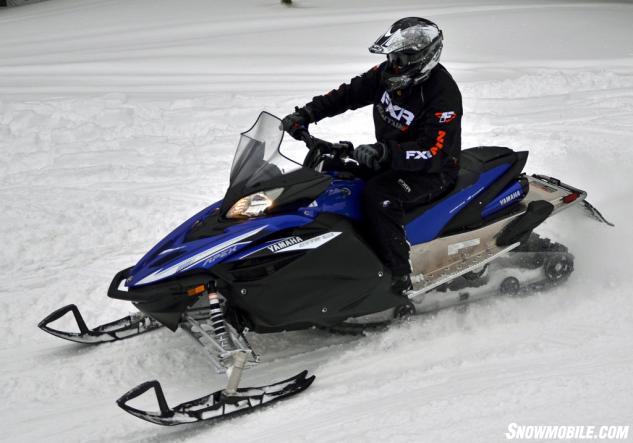
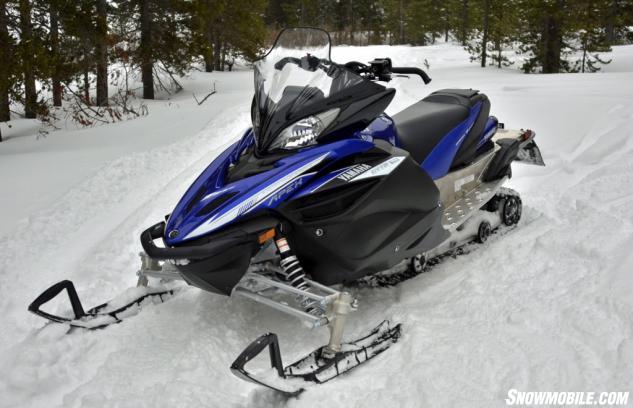
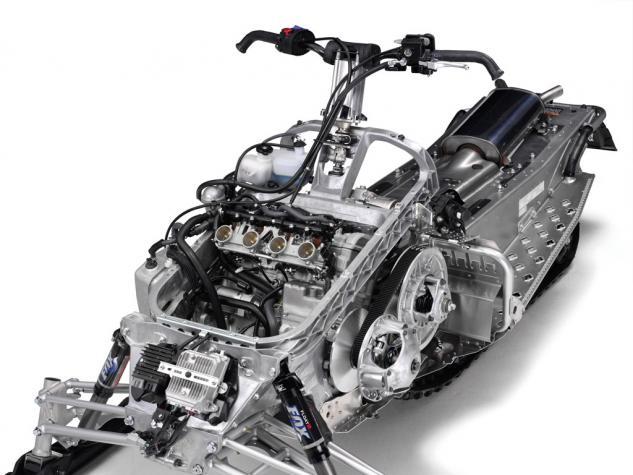


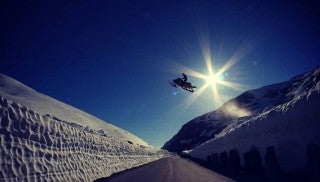


 Your Privacy Choices
Your Privacy Choices